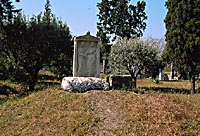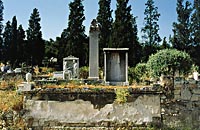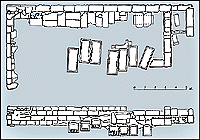|
Some Classical Athenian graves were surrounded by a
four-sided circuit wall; others were arranged into a tomb mound.
The mound normally had a circular base of stones containing a
mass of earth. Often the monument was plastered over and capped
with a gravestone,
statue, or pot. If a mound had a fairly large base diameter, it would
cover a group of graves; if a fairly small base diameter,
it would cover no more than a single grave. There are a number
of mounds that were used for more than one generation, and here the
dead were obviously members of the same family. (This is also
implied by the fact that the earliest of the graves had not been
disturbed). Archaeological finds apart, burial mounds are
mentioned and described by ancient writers, and also appear on
Attic pots.
|

 |







